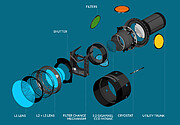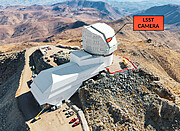Construction of Largest Digital Camera Ever Built for Astronomy Completed
SLAC celebrates the completion of Vera C. Rubin Observatory’s 3200-megapixel camera
3 April 2024
The world’s largest digital camera for astronomy is complete. Once in place on a telescope in Chile, the LSST Camera will gather an unprecedented amount of data about our Universe, yielding new insights into everything from dark energy to asteroids.
After two decades of work, scientists and engineers at the Department of Energy’s SLAC National Accelerator Laboratory and their collaborators are celebrating the completion of the LSST Camera. Once mounted on Vera C. Observatory’s Simonyi Survey Telescope, the 3200-megapixel camera will help researchers observe our Universe in unprecedented detail. During its ten-year Legacy Survey of Space and Time, the LSST Camera will generate an enormous trove of data on the southern night sky that researchers will mine for new insights into dark energy, dark matter, the changing night sky, the Milky Way and our Solar System.
Vera C. Rubin Observatory is jointly funded by the U.S. National Science Foundation (NSF) and the U.S. Department of Energy (DOE), and is a Program of NSF NOIRLab, which, along with SLAC, will cooperatively operate Rubin.
“With the completion of the unique LSST Camera at SLAC and its imminent integration with the rest of Rubin Observatory systems in Chile, we will soon start producing the greatest movie of all time and the most informative map of the night sky ever assembled,” said Director of Rubin Observatory Construction and University of Washington professor Željko Ivezić.
To achieve that goal, the SLAC team and its partners built the largest digital camera ever constructed for astronomy. The camera is roughly the size of a small car and weighs around 3000 kilograms (6600 lbs), and its front lens is over 1.5 meters (5 feet) across — the largest lens ever made for this purpose. Another lens, that is 90 centimeters (3 feet) wide, had to be specially designed to seal the vacuum chamber that houses the camera’s enormous focal plane. That focal plane is made up of 201 individual custom-designed CCD sensors, and it is so flat that its surface varies by no more than a tenth of the width of a human hair. The pixels themselves are only 0.01 mm (10 microns) wide.
Still, the camera’s most important feature is its ability to capture detail over an unprecedented field of view. It is so great that it would take hundreds of ultra-high-definition TVs to display just one of its images at full size. “Its images are so detailed that it could resolve a golf ball from around 25 kilometers (15 miles) away, while covering a swath of the sky seven times wider than the full Moon. These images, with billions of stars and galaxies, will help unlock the secrets of the Universe,” said SLAC professor and Rubin Observatory Deputy Director and Camera Program Lead Aaron Roodman.
“And those secrets are increasingly important to reveal,” said Kathy Turner, program manager for the DOE’s Cosmic Frontier Program. “More than ever before, expanding our understanding of fundamental physics requires looking farther out into the Universe. With the LSST Camera at its core, Rubin Observatory will delve deeper than ever before into the cosmos and help answer some of the hardest, most important questions in physics today.”
Now that the LSST Camera is complete and has been thoroughly tested at SLAC, it will be packed up and shipped to Chile and driven 2737 meters (8980 feet) up Cerro Pachón in the Andes, where it will be hoisted onto the Simonyi Survey Telescope later this year.
“Rubin Observatory Operations is very excited to see this major milestone about to be completed by the construction team,” said Bob Blum, Director for Operations for Vera C. Rubin Observatory. “Combined with the progress of coating the primary mirror, this brings us confidently and much closer to starting the Legacy Survey of Space and Time. It is happening.”
The LSST Camera’s essential purpose is to map the positions and measure the brightness of a vast number of night-sky objects. From the robust catalog that Rubin builds, researchers will be able to infer a wealth of information. Perhaps most notably, the LSST Camera will look for signs of weak gravitational lensing, when massive galaxies subtly bend the light from more distant background galaxies. Weak lensing helps astronomers study the distribution of mass in the Universe and how it’s changed over time.
Scientists also want to study patterns in the distribution of galaxies and how those have changed over time, identifying clusters of dark matter and spotting supernovae, all of which can help further our understanding of dark matter and dark energy alike.
Even closer to home, researchers are hoping to create a far more thorough census of the many small objects in our Solar System, which could lead to a new understanding of how our Solar System formed and perhaps help identify threats from asteroids that get a little too close to Earth.
With the LSST Camera, researchers expect to produce a far more detailed understanding of our Universe, yielding insights into its structure and evolution as well as the nature of objects within it.
Among the partner labs that contributed expertise and technology are Brookhaven National Laboratory, which built the camera's digital sensor array, Lawrence Livermore National Laboratory, which with its industrial partners designed and built lenses for the camera, and the National Institute of Nuclear and Particle Physics at the National Center for Scientific Research (IN2P3/CNRS) in France, which contributed to sensor and electronics design and built the camera's filter exchange system, which together will allow the camera to home in on six separate bands of light from the ultraviolet to infrared.
Email mgnida@slac.stanford.edu to attend LSST Media Day at SLAC on 11-12 April. RSVP by 29 March.
More information
NSF NOIRLab (U.S. National Science Foundation National Optical-Infrared Astronomy Research Laboratory), the U.S. center for ground-based optical-infrared astronomy, operates the International Gemini Observatory (a facility of NSF, NRC–Canada, ANID–Chile, MCTIC–Brazil, MINCyT–Argentina, and KASI–Republic of Korea), Kitt Peak National Observatory (KPNO), Cerro Tololo Inter-American Observatory (CTIO), the Community Science and Data Center (CSDC), and Vera C. Rubin Observatory (operated in cooperation with the Department of Energy’s SLAC National Accelerator Laboratory). It is managed by the Association of Universities for Research in Astronomy (AURA) under a cooperative agreement with NSF and is headquartered in Tucson, Arizona. The astronomical community is honored to have the opportunity to conduct astronomical research on I’oligam Du’ag (Kitt Peak) in Arizona, on Maunakea in Hawai‘i, and on Cerro Tololo and Cerro Pachón in Chile. We recognize and acknowledge the very significant cultural role and reverence that these sites have to the Tohono O’odham Nation, to the Native Hawaiian community, and to the local communities in Chile, respectively.
Vera C. Rubin Observatory is a Federal project jointly funded by the National Science Foundation (NSF) and the Department of Energy (DOE) Office of Science, with early construction funding received from private donations through the LSST Discovery Alliance. The NSF-funded Rubin Observatory Project Office for construction was established as an operating center under the management of the Association of Universities for Research in Astronomy (AURA). The DOE-funded effort to build the Rubin Observatory LSST Camera is managed by SLAC National Accelerator Laboratory (SLAC).
SLAC is operated by Stanford University for the U.S. Department of Energy’s Office of Science. The Office of Science is the single largest supporter of basic research in the physical sciences in the United States and is working to address some of the most pressing challenges of our time.
The U.S. National Science Foundation (NSF) is an independent federal agency created by Congress in 1950 to promote the progress of science. NSF supports basic research and people to create knowledge that transforms the future.
NSF and DOE will continue to support Rubin Observatory in its Operations phase via NSF NOIRLab and DOE’s SLAC.
Links
Contacts
Manuel Gnida
Media Relations Manager
SLAC National Accelerator Laboratory
Email: mgnida@slac.stanford.edu
Kristen Metzger
Communications Manager for Education and Public Outreach
Rubin Observatory
Email: kristen.metzger@noirlab.edu
Bob Blum
Director for Operations, Vera C. Rubin Observatory
NSF NOIRLab
Tel: +1 520-318-8233
Email: bob.blum@noirlab.edu
Josie Fenske
Jr. Public Information Officer
NSF NOIRLab
Email: josie.fenske@noirlab.edu
Luz María Aguirre
AURA Communications and Institutional Relations Manager
Email: laguirre@aura-astronomy.org






